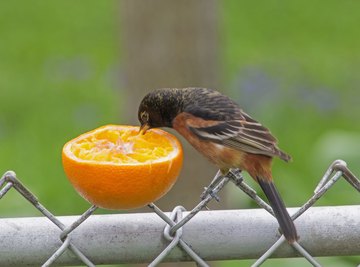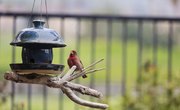
Backyard birdwatching entertains an estimated 65 million people in the U.S. With more than 900 confirmed species in North America north of Mexico, there are plenty of birds to watch.
Some experts estimate there actually may be more than 2,200 bird species in North America and more than 22,000 bird species around the world. Add oranges and other fresh fruits to your feeder options to attract a wider variety of these birds to your yard.
Learn Your Local Birds
Before randomly setting out oranges or other foods, learn what species live in or migrate through your area. State extension offices, local bird-watching organizations and bird identification books (regional or national) such as Audubon books and bird websites such as eBird will help you identify local species.
Neighbors with bird feeders can provide a rich source of information and advice, too.
Once you know what species to expect, you'll better know what foods and what type(s) of feeders the local and migratory birds prefer. Now you are ready to set up your feeders and invite your feathered friends over. Once you've established your bird feeders, consider keeping a log of your visitors. Be a citizen scientist by adding your information to websites like eBird.
Birds That Like Oranges
Orioles really like oranges. So do mockingbirds, tanagers and catbirds. Other birds that like fruit include:
- Bluebirds
- Thrashers
- Cardinals
- Woodpeckers
- Jays
- Starlings
- Thrushes
- Cedar waxwings
- Yellow-breasted chats
While these birds are known to like oranges, that doesn't mean they'll all prefer oranges, so just keep that in mind. Not all of these birds live in or migrate to all regions, of course.
But an orange offering may entice an unexpected guest or two, even if you don't live where orioles visit.
Orange Slice Bird Feeder
Feeding oranges to birds can be as easy as slicing oranges and setting them out for the birds. The best orange slice bird feeder is a platform feeder, but sliced oranges also can be hung from a nail on a tree or placed in a suet-style feeder.
If orioles travel through or stop to visit in your region, oriole food may be scarce when they arrive in spring. A fresh orange may tempt one or more into the yard.
An ideal oriole feeder consists of a platform feeder, a flat container placed on or near the ground. Simply place the cut orange or other fruit (try apples slices, ripe bananas, melon chunks or cut grapes) on the platform. Be sure to throw away any older or moldy food and wash the platform regularly to help keep the birds healthy.
Shelter Your Feeder
To further welcome your winged guests, place your feeder within 10 feet of trees or other shelter. Have a water source available. Plant flowers and trees that appeal to the birds in your area. For orioles, consider planting crabapple trees, honeysuckle, trumpet vine and raspberries (although you might choose to net some of the raspberry plants for yourself).
Unwelcome visitors to the platform feeder can be squirrels, mice or rats and unexpected birds. Raise the platform off the ground and encase the support post with a smooth tube like a PVC pipe (minimum 5-inch diameter) to prevent climbing by squirrels, rats and mice. A 1.5-inch wire mesh over the platform feeder may help limit access by larger birds, cats or other predators.
Birds that eat oranges in winter may switch to seeds or insects in the summer. Don't be discouraged if your platform feeder becomes less popular when nature provides food. Keep offering a little food, monitor the feeder(s) and increase the quantity when the birds return.
Other Feeder Options
To reduce unwelcome winged visitors to the platform feeder, try putting out different feeders with foods your unexpected guests prefer. Tube feeders provide individual perches.
Hopper feeders let several birds eat at once but can be messy and wasteful when birds pick through to select their meal and drop the rejected food on the ground. Suet feeders have a wire cage that hold a suet or similar food cake.
Special feeders made with fine wire or cloth mesh can be used for tiny thistle seeds. Popular bird foods, in general, include sunflower seeds, white millet, thistle or Nyjer seeds, peanuts and suet. Hummingbirds prefer nectar.
What's a Squirrel's Favorite Food?
Offering squirrels their own menu may reduce their efforts to raid the bird feeders. Excellent squirrel foods include nuts in their shells such as white oak acorns, beechnuts, hazelnuts, hickory, pecans and walnuts. Peanuts, however, do not meet the gnawing or nutritional needs of squirrels, and raw peanuts may have a fungus toxic to squirrels.
Butternut squash with its rind, small quantities of fruits (apples, cantaloupe, grapes, strawberries and watermelon) and vegetables like broccoli, carrots, peas, yellow squash and zucchini offer excellent nutrition for squirrels.
Foods squirrels like but should only receive in small quantities include corn, peanut butter, roasted but unsalted peanuts, pistachios, pumpkin and pumpkin seeds and sunflower seeds.
References
- Notes from the Road: How Many Birds are in North America?
- American Museum of Natural History: New Study Doubles the Estimate of Bird Species in the World
- Birds and Blooms: Feeding Birds with Oranges
- Perky-Pet: What to Feed Squirrels
- Pennsylvania State University Extension: Winter Bird Feeding - The Basics
- University of Maine Extension: Bird Feeding Basics
Resources
Tips
- You can also purchase special fruit feeders in home and garden centers.
Warnings
- If the orange begins to mold, remove it and replace it with a fresh one.
About the Author
Karen earned her Bachelor of Science in geology. She worked as a geologist for ten years before returning to school to earn her multiple subject teaching credential. Karen taught middle school science for over two decades, earning her Master of Arts in Science Education (emphasis in 5-12 geosciences) along the way. Karen now designs and teaches science and STEAM classes.
